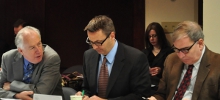
What will be the drivers of global migration in 2030? What will be the reactions – political, economic, and social – of countries that receive migrants? The Strategic Foresight Initiative and the US National Intelligence Council (NIC) January 11th hosted the workshop “A New World of Global Migration” to inform the NICs global trends 2030 project.
NIC Counselor Mathew Burrows, author of the Global Trends 2030 report to be released in December 2012, set the framework for the workshop. Burrows said the NIC wanted to examine how international migration would likely be a major factor not only between developing and developed countries but also between developing countries and emerging powers. He called for exploring the ramification of migration for governance, international relations, and society, noting that these are interrelated factors. Moreover, Burrows said, it is important to consider not only relatively certain migration trends but also potential shocks and disruptive change produced by the trends but leading to discontinuous change.
Jack Goldstone of George Mason University noted that income disparities drive migration and that it is likely there will be a large increase of people moving from the poorer half of the world to the more successful developing countries. This migrant flow, he said, is likely to be larger than the flow to developed countries.
Luca Barbone of Georgetown University pointed out that there are diverse reasons for migration besides economic opportunities. Large numbers of migrants are refugees, many are students, and many are family members reuniting. Barbone also noted that many people think there is a huge percentage of the global population that constitutes migrants but that, in reality, migrants comprise only 3% of the world’s population.
Madeleine Sumption of the Migration Policy Institute and Christopher Rudolph of American University led the subsequent discussion regarding potential reactions to migration of receiving states and the policy-making challenges ahead. The next twenty years will see increased short-term stays, rather than long-term migration, a trend that poses tangible challenges to the structure of current migration policies and the notion of citizenship. The global battle for talent will be a core issue for policy of receiving states, which will be increasingly pressed to find better means to recruit the best and the brightest worldwide. Technology, as well as flexible and easily adaptable border security and immigration standards, will be elemental tools in this effort.
Kelly Ryan, from the Department of Homeland Security, focused her concluding remarks on the increasing importance of IT, biometrics, and personal data sharing as shapers of migration policy, and the crucial role of the US in leading global migration reform efforts.
Banning Garrett, Director of the Atlantic Council’s Strategic Foresight Initiative, noted that Nobel Laureate Michael Spence suggests that the world is moving toward re-convergence of per capita GDP, bringing the 75% of the world’s population to the level of the advanced countries by 2050. Even by then by 2030, he said, this convergence might have a major effect on the drivers of migration and where migrants might want to go. This is part of a shift in the world economy which can be seen now in the increase of south-south trade, which changes the picture of migration globally, especially as this trade and investment is increasingly in high-tech and industrial goods. China is selling trains, planes and automobiles to Brazil, for example. There are also huge numbers of workers from developing country corporations working in other countries like Chinese workers in African resource extraction projects. Garrett also pointed to the growing demand for resources and the lack of supply that, paired with climate change, will have a big impact on global migration.
